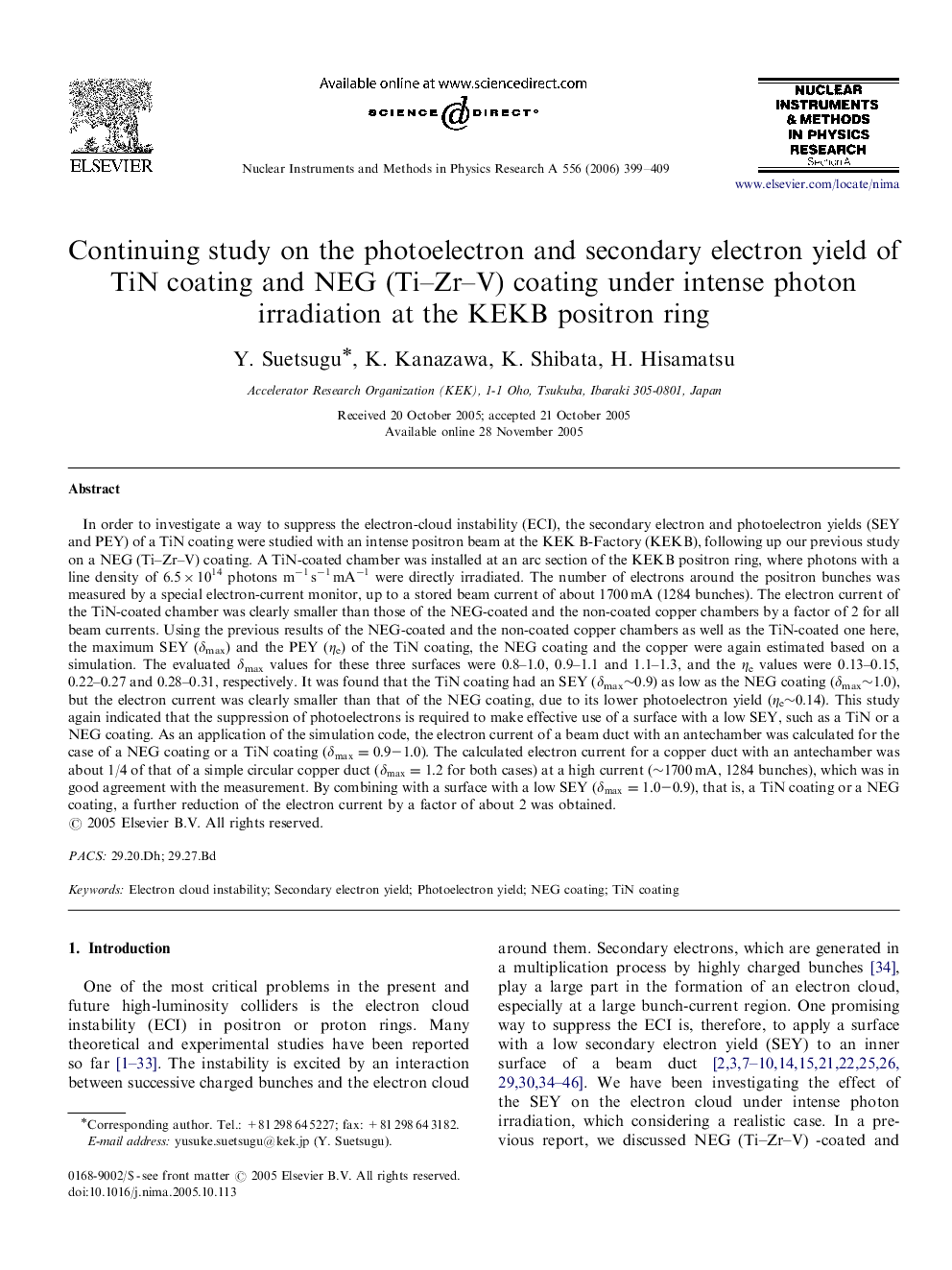| کد مقاله | کد نشریه | سال انتشار | مقاله انگلیسی | نسخه تمام متن |
|---|---|---|---|---|
| 1833665 | 1027561 | 2006 | 11 صفحه PDF | دانلود رایگان |
عنوان انگلیسی مقاله ISI
Continuing study on the photoelectron and secondary electron yield of TiN coating and NEG (Ti-Zr-V) coating under intense photon irradiation at the KEKB positron ring
دانلود مقاله + سفارش ترجمه
دانلود مقاله ISI انگلیسی
رایگان برای ایرانیان
کلمات کلیدی
موضوعات مرتبط
مهندسی و علوم پایه
فیزیک و نجوم
ابزار دقیق
پیش نمایش صفحه اول مقاله

چکیده انگلیسی
In order to investigate a way to suppress the electron-cloud instability (ECI), the secondary electron and photoelectron yields (SEY and PEY) of a TiN coating were studied with an intense positron beam at the KEK B-Factory (KEKB), following up our previous study on a NEG (Ti-Zr-V) coating. A TiN-coated chamber was installed at an arc section of the KEKB positron ring, where photons with a line density of 6.5Ã1014 photons mâ1 sâ1 mAâ1 were directly irradiated. The number of electrons around the positron bunches was measured by a special electron-current monitor, up to a stored beam current of about 1700 mA (1284 bunches). The electron current of the TiN-coated chamber was clearly smaller than those of the NEG-coated and the non-coated copper chambers by a factor of 2 for all beam currents. Using the previous results of the NEG-coated and the non-coated copper chambers as well as the TiN-coated one here, the maximum SEY (δmax) and the PEY (ηe) of the TiN coating, the NEG coating and the copper were again estimated based on a simulation. The evaluated δmax values for these three surfaces were 0.8-1.0, 0.9-1.1 and 1.1-1.3, and the ηe values were 0.13-0.15, 0.22-0.27 and 0.28-0.31, respectively. It was found that the TiN coating had an SEY (δmaxâ¼0.9) as low as the NEG coating (δmaxâ¼1.0), but the electron current was clearly smaller than that of the NEG coating, due to its lower photoelectron yield (ηeâ¼0.14). This study again indicated that the suppression of photoelectrons is required to make effective use of a surface with a low SEY, such as a TiN or a NEG coating. As an application of the simulation code, the electron current of a beam duct with an antechamber was calculated for the case of a NEG coating or a TiN coating (δmax=0.9-1.0). The calculated electron current for a copper duct with an antechamber was about 1/4 of that of a simple circular copper duct (δmax=1.2 for both cases) at a high current (â¼1700 mA, 1284 bunches), which was in good agreement with the measurement. By combining with a surface with a low SEY (δmax=1.0-0.9), that is, a TiN coating or a NEG coating, a further reduction of the electron current by a factor of about 2 was obtained.
ناشر
Database: Elsevier - ScienceDirect (ساینس دایرکت)
Journal: Nuclear Instruments and Methods in Physics Research Section A: Accelerators, Spectrometers, Detectors and Associated Equipment - Volume 556, Issue 2, 15 January 2006, Pages 399-409
Journal: Nuclear Instruments and Methods in Physics Research Section A: Accelerators, Spectrometers, Detectors and Associated Equipment - Volume 556, Issue 2, 15 January 2006, Pages 399-409
نویسندگان
Y. Suetsugu, K. Kanazawa, K. Shibata, H. Hisamatsu,